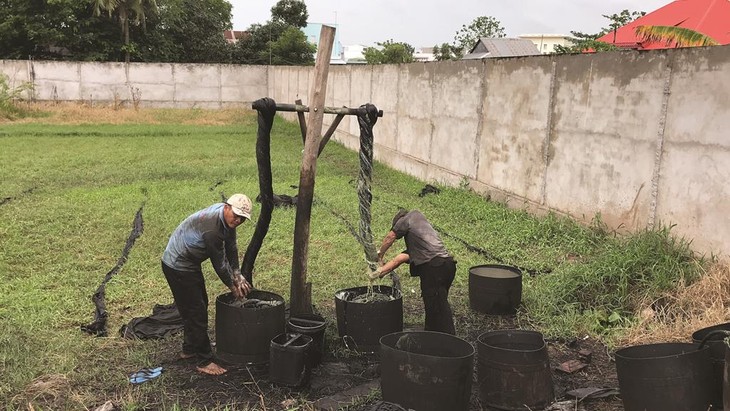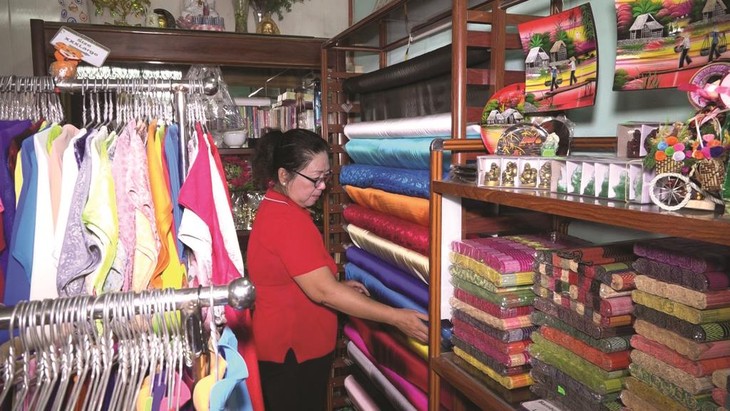(VOVWORLD) - Tan Chau town in An Giang province is home to “Lanh My A”, a luxuriously soft and beautiful handmade silk.
 Artisans in Tan Chau village use “mac nua” berries to dye Lanh My A silk. (Photo: baoangiang.com.vn) Artisans in Tan Chau village use “mac nua” berries to dye Lanh My A silk. (Photo: baoangiang.com.vn) |
In the 1920s, most of the residents of Long Hung village (now Long Chau ward in Tan Chau town) were engaged in growing mulberry trees, raising silkworms, and weaving silk. By the 1940s, Tan Chau had become the biggest silk center in the Mekong Delta and part of the legendary "silk road".
At its peak, the sound of looms and dying activities were ubiquitous in Tan Chau from dawn to dusk. By the 1960s, Tan Chau silk products were exported to Thailand, Laos, and Cambodia. In its heyday, Tan Chau had 60 weaving workshops and 120 silkworm incubators. It used 4,000-6,000 tons of silk thread per year.
Lanh My A silk fabric must satisfy three requirements: it must be made entirely of natural silk; it must be woven using the satin-8 technique (the most difficult weaving technique); and it must be dyed with a type of fruit called “mac nua” (diospyros mollis). Villagers say mac nua fruit is similar to longan. It takes five years to harvest the first mac nua fruits.
What makes Lanh My A silk so precious and expensive is that it is made from premium silk fibers and died jet-black.
Le Thi Kieu Hanh with the Hong Ngoc silk weaving workshop said, “Mac nua fruits are crushed to get the latex used to dye Lanh My A silk. That tree is very rare now. The growing area is so small that it’s hard to get enough fruits to dye Lanh My A silk.”
The “mac nua” berries should be immature and have a yellowish-green color. They’re ground into powder, filtered to remove any residue, and mixed with water to form a thick latex. The color gradually changes from golden to black. The dyer dips lengths of silk fabric into the latex so that each thread is evenly soaked.
Ms. Hanh recalls, “When the mac nua fruit is ground, its powder is slightly yellowish. When it dries, it slowly turns black. It takes about one month and a half to produce a black piece of silk cloth like this.”
 Tan Chau silk products on display (Photo: baoangiang.com.vn) Tan Chau silk products on display (Photo: baoangiang.com.vn) |
About 90 kilos of mac nua fruit are needed to dye a 21m long roll of silk. Dyeing the silk is the most time-consuming step, as it requires soaking the silk in the dye a hundred times to ensure that each silk thread absorbs the color.
Bright sunshine is needed to dry the silk. The quality of the silk will deteriorate if it’s exposed to rain or weak sunlight. After 40 to 45 days of drying comes five to seven days of beating the silk so that the mac nua resin penetrates deeply into each silk thread and makes the silk soft and glossy.
Producing a beautiful piece of Lanh My A silk with a glossy black color requires further stages of starching and rinsing, said Nguyen Huu Tri, an artisan with a Lanh My A production facility in Tan Chau.
“After 10 to 12 days of dyeing, the silk will be washed with water to remove any excess resin on the fabric, then comes the beating process. Washing and beating continue for another nine or ten days before the second dye. We keep doing like this many more times with the distance between each period shorter,” Tri noted.
What makes Lanh My A silk stand out is its softness, toughness, durability, and high absorbency. Clothes made from this silk give the wearer a comfortable, cool feeling in the summer and a comfortable warm feeling in the winter.
According to Nguyen Van Long of Tan Chau town, “Lanh My A is a type of silk that goes well with the mac nua fruit. The fruit is not so good for dyeing other types of cloth.”
Because Tan Chau silk takes so long and requires so much effort to make, it became too expensive for ordinary use in the 1960s. The mac nua orchards all but disappeared, the mulberry growing area was reduced, and the silk weaving craft started to decline. To preserve and promote local silk weaving, in 2006 the An Giang provincial People's Committee recognized Tan Chau as a traditional silk craft village.